最新人教版四年级英语上册教案全套
人教版四年级上册英语教案15篇

人教版四年级上册英语教案15篇(经典版)编制人:__________________审核人:__________________审批人:__________________编制单位:__________________编制时间:____年____月____日序言下载提示:该文档是本店铺精心编制而成的,希望大家下载后,能够帮助大家解决实际问题。
文档下载后可定制修改,请根据实际需要进行调整和使用,谢谢!并且,本店铺为大家提供各种类型的经典范文,如工作总结、工作计划、演讲致辞、规章制度、合同协议、条据文书、励志名言、好词好句、教学资料、其他范文等等,想了解不同范文格式和写法,敬请关注!Download tips: This document is carefully compiled by this editor. I hope that after you download it, it can help you solve practical problems. The document can be customized and modified after downloading, please adjust and use it according to actual needs, thank you!Moreover, our store provides various types of classic sample essays, such as work summaries, work plans, speeches, rules and regulations, contract agreements, policy documents, inspirational quotes, good words and sentences, teaching materials, other sample essays, and more. If you want to learn about different sample formats and writing methods, please stay tuned!人教版四年级上册英语教案15篇人教版四年级上册英语教案范文15篇教案可以帮助教师组织教学内容,包括选择教材、确定教学重点和难点,设计教学活动和任务等。
人教版小学四年级英语上册教案5篇
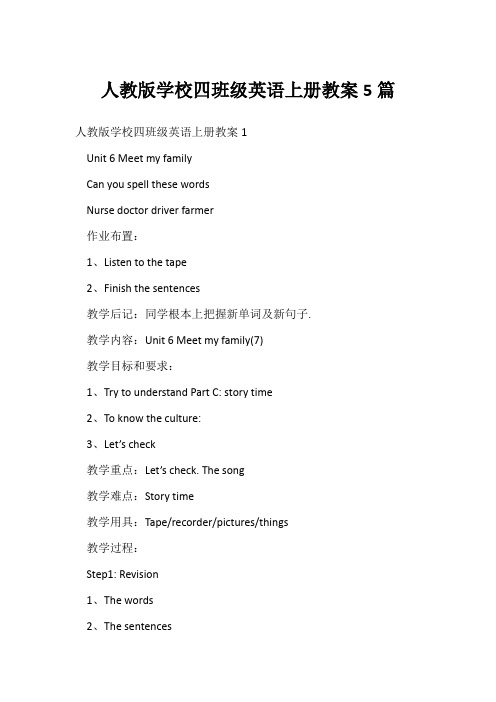
人教版学校四班级英语上册教案5篇人教版学校四班级英语上册教案1Unit 6 Meet my familyCan you spell these wordsNurse doctor driver farmer作业布置:1、Listen to the tape2、Finish the sentences教学后记:同学根本上把握新单词及新句子.教学内容:Unit 6 Meet my family(7)教学目标和要求:1、Try to understand Part C: story time2、To know the culture:3、Let’s check教学重点:Let’s check. The song教学难点:Story time教学用具:Tape/recorder/pictures/things教学过程:Step1: Revision1、The words2、The sentencesStep2:Finish ‘Let’s check〞1、Listen and chose the right answer.2、Check your answers.Step3: Story time1、Look at the pictures2、Try to understand the story3、Listen to the tape4、Say after the tapeStep4: CultureStep5: Let’s sing: Read the song1、Listen to the tape2、Sing togetherStep6:Summary and homework板书设计:Unit 6 Meet my family (7)Good to know. Mom mother作业布置:1、Listen to the tape2、Sing the song.教学后记:同学的练习反应状况较好。
人教版小学英语四年级上册教案(全册)
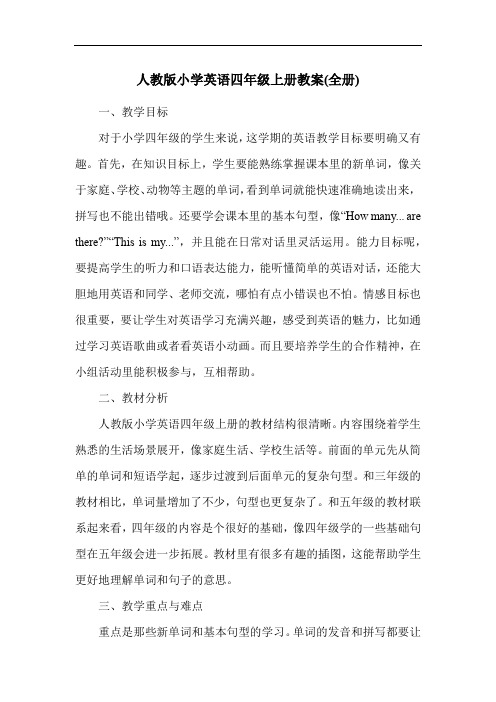
人教版小学英语四年级上册教案(全册)一、教学目标对于小学四年级的学生来说,这学期的英语教学目标要明确又有趣。
首先,在知识目标上,学生要能熟练掌握课本里的新单词,像关于家庭、学校、动物等主题的单词,看到单词就能快速准确地读出来,拼写也不能出错哦。
还要学会课本里的基本句型,像“How many... are there?”“This is my...”,并且能在日常对话里灵活运用。
能力目标呢,要提高学生的听力和口语表达能力,能听懂简单的英语对话,还能大胆地用英语和同学、老师交流,哪怕有点小错误也不怕。
情感目标也很重要,要让学生对英语学习充满兴趣,感受到英语的魅力,比如通过学习英语歌曲或者看英语小动画。
而且要培养学生的合作精神,在小组活动里能积极参与,互相帮助。
二、教材分析人教版小学英语四年级上册的教材结构很清晰。
内容围绕着学生熟悉的生活场景展开,像家庭生活、学校生活等。
前面的单元先从简单的单词和短语学起,逐步过渡到后面单元的复杂句型。
和三年级的教材相比,单词量增加了不少,句型也更复杂了。
和五年级的教材联系起来看,四年级的内容是个很好的基础,像四年级学的一些基础句型在五年级会进一步拓展。
教材里有很多有趣的插图,这能帮助学生更好地理解单词和句子的意思。
三、教学重点与难点重点是那些新单词和基本句型的学习。
单词的发音和拼写都要让学生掌握好,像“library”“playground”这些单词的发音有点难,要多练习。
句型方面,“There be”句型的用法是个重点,要让学生明白什么时候用“is”,什么时候用“are”。
难点在于一些语法知识,虽然对于四年级学生不能讲得太深奥,但像名词的单复数形式,在句子里的正确使用就不容易。
还有一些容易混淆的单词,像“big”和“pig”,学生很可能会搞错,得想办法让他们区分清楚。
四、教学方法在小学英语四年级上册的教学过程中,我将采用多种创新的教学方法,以适应小学生的学习特点,激发他们的学习兴趣并提高学习效果。
人教版小学四年级英语上册教案

人教版小学四年级英语上册教案关于人教版小学四年级英语上册教案5篇我们将详细介绍教学教案的编写方法和注意事项,希望能够给教师们提供一些实用的指导和帮助。
下面是作者为大家整理的人教版小学四年级英语上册教案,如果大家喜欢可以分享给身边的朋友。
人教版小学四年级英语上册教案(篇1)一、学情分析四年级学生已接触一年的英语学习,学生已经学过了26个英文字本母和部分单词,也掌握了该如何学习英语的一些基本方法。
但部分学生自觉性比较差,相应的学习习惯也差,开始学习英语的那种新鲜感已经丧失,学生的学习目的也不明确。
针对这种情况,教学上采取任务型教学,运用灵活多变的方法,实现学生语言运用能力的迁移和拓展。
尊重理解学生,与学生一起分享学习中的苦与乐,使每一位学生都能在学习中取得很大成绩,有所进步。
二、全册教学总目标根据学生情况与教材特点,在遵循基本指导思想的基础上,特定以下四个目标:1.根据小学生好奇好动的心理特点,在课堂上围绕各种知识要点,展开一系列的活动,强调学生的积极性,在愉快的教学环境中掌握知识和提高能力。
2.通过多种渠道各种方式让学生对运用英语的国家和民族有兴趣。
3.创设多种语言情境,紧密联系生活实际,让学生多听,多说,多写,多练,培养学生用英语做事情的能力。
4.在英语教学过程中,培养学生良好的日常学习习惯,引导学生用英语思维的能力,培养良好的语感,并结合日常教学进行思想教育。
三、全册教材分析本教材的教学目标是激发学生学习英语的兴趣,培养他们英语学习的积极态度,使他们建立初步的学习英语的自信心;培养学生装一定的'语感和良好的语音、语调,书写基础,以及良好的学习习惯;使他们形成初步用英语进行简单交流的能力,同时,培养学生的观察、记忆、思维和创造的能力。
1、强调语言运用本教材吸收了交际教学思想,注重学生语言应用能力的培养。
在整体构思、内容安排、活动设计和教学方法选用等方面都紧密联系学生的生活实际,体现语言的交际功能,把话题#功能#结构#任务结合起来,并根据学生的年龄特点,采用“全部动作反应法”让学生在有节奏的说唱中体验语言。
四年级上册英语教案人教版

四年级上册英语教案人教版第一章:Unit 1 My school1.1 Teaching objectives:(1) Knowledge objectives:Students can understand and use key words: school, classroom, teacher, student, library, playground, puter room, dining room.Students can understand and use sentence patterns: What's this? It'sWhat's that? It'sWhere is the? It's in/on/under(2) Ability objectives:Students can listen, speak, read and write the key words and sentence patterns.Students can describe the layout of their school.1.2 Teaching key and difficult points:The correct pronunciation and usage of key words and sentence patterns.The description of the layout of the school.1.3 Teaching procedures:Step 1: Warm-upReview previous knowledge: introduce oneself and askquestions.Step 2: PresentationShow pictures of a school and introduce the key words and sentence patterns.Practice asking and answering questions with the class.Step 3: PracticeGroup activity: students work in groups to describe the layout of their school.Step 4: ProductionStudents role-play the conversation between a teacher and students in a school.1.4 Homework:Copy the key words and sentence patterns.Practice describing the layout of their school with their parents.第二章:Unit 2 My family2.1 Teaching objectives:(1) Knowledge objectives:Students can understand and use key words: family, mother, father, sister, brother, grandmother, grandfather.Students can understand and use sentence patterns: This is my She/He is my(2) Ability objectives:Students can listen, speak, read and write the key words and sentence patterns.Students can introduce their family members.2.2 Teaching key and difficult points:The correct pronunciation and usage of key words and sentence patterns.Introducing family members correctly.2.3 Teaching procedures:Step 1: Warm-upReview previous knowledge: introduce oneself and ask questions.Step 2: PresentationShow pictures of a family and introduce the key words and sentence patterns.Practice asking and answering questions with the class.Step 3: PracticeGroup activity: students work in groups to introduce their family members.Step 4: ProductionStudents role-play the conversation between a person and their family members.2.4 Homework:Copy the key words and sentence patterns.Practice introducing their family members to their friends.第三章:Unit 3 My friends3.1 Teaching objectives:(1) Knowledge objectives:Students can understand and use key words: friend, like, have, fun, play, happy.Students can understand and use sentence patterns: Do you have any friends? Yes, I do. They are(2) Ability objectives:Students can listen, speak, read and write the key words and sentence patterns.Students can introduce their friends.3.2 Teaching key and difficult points:The correct pronunciation and usage of key words and sentence patterns.Introducing friends correctly.3.3 Teaching procedures:Step 1: Warm-upReview previous knowledge: introduce oneself and ask questions.Step 2: PresentationShow pictures of friends and introduce the key words and sentence patterns.Practice asking and answering questions with the class.Step 3: PracticeGroup activity: students work in groups to introduce their friends.Step 4: ProductionStudents role-play the conversation between a person and their friends.3.4 Homework:Copy the key words and sentence patterns.Practice introducing their friends to their parents.第四章:Unit 4 My home4.1 Teaching objectives:(1) Knowledge objectives:Students can understand and use key words: home, bedroom, living room, kitchen, bathroom, dining room.Students can understand and use sentence patterns: What's this? It'sWhere is the? It's in/on/under(2) Ability objectives:sentence patterns.Students can describe the layout of their home.4.2 Teaching key and difficult points:The correct pronunciation and usage of key words and sentence patterns.第四章:Unit 4 My home (续)4.3 Teaching procedures (continued):Step 5: ProductionStudents role-play the conversation between a person and their family member about their home.4.4 Homework:Copy the key words and sentence patterns.Practice describing the layout of their home with their parents. 第五章:Unit 5 My schoolbag5.1 Teaching objectives:(1) Knowledge objectives:Students can understand and use key words: schoolbag, pen, pencil, ruler, eraser, book, notebook.Students can understand and use sentence patterns: What's in your schoolbag? I have(2) Ability objectives:sentence patterns.Students can describe the contents of their schoolbag.5.2 Teaching key and difficult points:The correct pronunciation and usage of key words and sentence patterns.Describing the contents of the schoolbag correctly.5.3 Teaching procedures:Step 1: Warm-upReview previous knowledge: introduce oneself and ask questions.Step 2: PresentationShow pictures of a schoolbag and introduce the key words and sentence patterns.Practice asking and answering questions with the class.Step 3: PracticeGroup activity: students work in groups to describe the contents of their schoolbags.Step 4: ProductionStudents role-play the conversation between a person and their friend about their schoolbags.5.4 Homework:Copy the key words and sentence patterns.Practice describing the contents of their schoolbag to their parents.第六章:Unit 6 Clothes6.1 Teaching objectives:(1) Knowledge objectives:Students can understand and use key words: clothes, shirt, pants, dress, skirt, shoes, hat, coat.Students can understand and use sentence patterns: What's this? It'sDo you like? Yes, I do./No, I don't.(2) Ability objectives:Students can listen, speak, read and write the key words and sentence patterns.Students can describe the clothes they like.6.2 Teaching key and difficult points:The correct pronunciation and usage of key words and sentence patterns.Describing the clothes correctly.6.3 Teaching procedures:Step 1: Warm-upReview previous knowledge: introduce oneself and askquestions.Step 2: PresentationShow pictures of clothes and introduce the key words and sentence patterns.Practice asking and answering questions with the class.Step 3: PracticeGroup activity: students work in groups to describe the clothes they like.Step 4: ProductionStudents role-play the conversation between a person and their friend about their clothes.6.4 Homework:Copy the key words and sentence patterns.Practice describing the clothes they like to their parents.第七章:Unit 7 Food7.1 Teaching objectives:(1) Knowledge objectives:Students can understand and use key words: food, rice, noodles, bread, meat, fish, vegetable, fruit.Students can understand and use sentence patterns: Do you like? Yes, I do./No, I don't.What's your favorite food? My favorite food is(2) Ability objectives:Students can listen, speak, read and write the key words and sentence patterns.Students can talk about their favorite food.7.2 Teaching key and difficult points:The correct pronunciation and usage of key words and sentence patterns.Talking about favorite food correctly.7.3 Teaching procedures:Step 1: Warm-upReview previous knowledge: introduce oneself and ask questions.Step 2: PresentationShow pictures of food and introduce the key words and sentence patterns.Practice asking and answering questions with the class.Step 3: PracticeGroup activity: students work in groups to talk about their favorite food.Step 4: ProductionStudents role-play the conversation between a person and their friend about their favorite food.7.4 Homework:Copy the key words and sentence patterns.Practice talking about their favorite food to their parents.第八章:Unit 8 Animals8.1 Teaching objectives:(1) Knowledge objectives:Students can understand and use key words: animal, cat, dog, fish, bird, elephant, tiger, lion.Students can understand and use sentence patterns: What's this? It'sDo you like? Yes, I do./No, I don't.(2) Ability objectives:Students can listen, speak, read and write the key words and sentence patterns.Students can describe the animals they like.8.2 Teaching key and difficult points:The correct pronunciation and usage of key words and sentence patterns.Describing animals correctly.8.3 Teaching procedures:Step 1: Warm-upReview previous knowledge: introduce oneself and askquestions.Step 2: PresentationShow pictures of animals and introduce the key words and sentence patterns.Practice asking and answering questions with the class.Step 3: PracticeGroup activity: students work in groups to describe the animals they like.Step 4: ProductionStudents role-play the conversation between a person and their friend about their favorite animal.8.4 Homework:Copy the key words and sentence patterns.Practice describing the animals they like to their parents.第九章:Unit 9 Colors9.1 Teaching objectives:(1) Knowledge objectives:Students can understand and use key words: color, red, yellow, blue, green, purple, orange, black, white.Students can understand and use sentence patterns: What color is it? It'sI likecolor.(2) Ability objectives:Students can listen, speak, read and write the key words and sentence patterns.Students can talk about colors.9.2 Teaching key and difficult points:The correct pronunciation and usage of key words and sentence patterns.Talking about colors correctly.9.3 Teaching procedures:Step 1: Warm-upReview previous knowledge: introduce oneself and ask questions.Step 2: PresentationShow pictures of colors and introduce the key words and sentence patterns.Practice asking and answering questions with the class.Step 3: PracticeGroup activity: students work in groups to talk about their favorite color.Step 4: ProductionStudents role-play the conversation between a person and their friend about their favorite color.9.4 Homework:Copy the key words and sentence patterns.Practice talking about their favorite color to their parents.第十章:Unit 10 At the farm10.1 Teaching objectives:(1) Knowledge objectives:Students can understand and use key words: farm, cow, horse, chicken, sheep, pig, tractor.Students can understand and use sentence patterns: What's this? It'sLook! There are(2) Ability objectives:Students can listen, speak, read and write the key words and sentence patterns.Students can describe what they see at the farm.10.2 Teaching key and difficult points:The correct pronunciation and usage of key words and sentence patterns.Describing the farm correctly.10.3 Teaching procedures:Step 1: Warm-upReview previous knowledge: introduce oneself and askquestions.Step 2: PresentationShow pictures of a farm and introduce the key words and sentence patterns.Practice asking and answering questions with the class.Step 3: PracticeGroup activity: students work in groups to describe what they see at the farm.Step 4: ProductionStudents role-play the conversation between a person and their friend at the farm.10.4 Homework:Copy the key words and sentence patterns.Practice describing what they see at the farm to their parents. 重点和难点解析第一章:Unit 1 My school重点:学校相关词汇和句型的学习和使用。
人教版四年级上册英语教案(5篇)
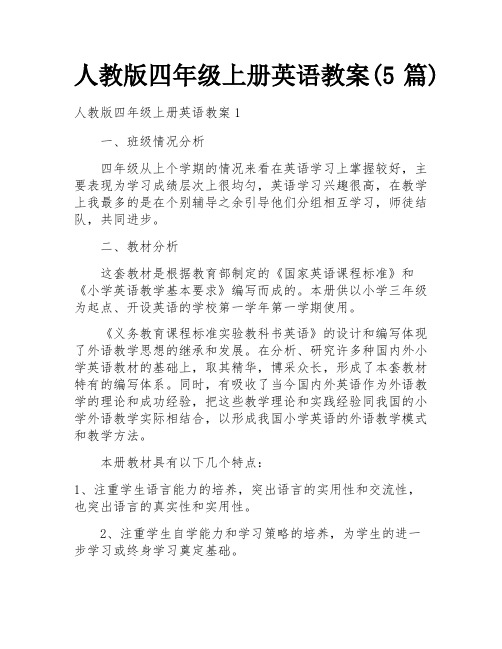
人教版四年级上册英语教案(5篇)人教版四年级上册英语教案1一、班级情况分析四年级从上个学期的情况来看在英语学习上掌握较好,主要表现为学习成绩层次上很均匀,英语学习兴趣很高,在教学上我最多的是在个别辅导之余引导他们分组相互学习,师徒结队,共同进步。
二、教材分析这套教材是根据教育部制定的《国家英语课程标准》和《小学英语教学基本要求》编写而成的。
本册供以小学三年级为起点、开设英语的学校第一学年第一学期使用。
《义务教育课程标准实验教科书英语》的设计和编写体现了外语教学思想的继承和发展。
在分析、研究许多种国内外小学英语教材的基础上,取其精华,博采众长,形成了本套教材特有的编写体系。
同时,有吸收了当今国内外英语作为外语教学的理论和成功经验,把这些教学理论和实践经验同我国的小学外语教学实际相结合,以形成我国小学英语的外语教学模式和教学方法。
本册教材具有以下几个特点:1、注重学生语言能力的培养,突出语言的实用性和交流性,也突出语言的真实性和实用性。
2、注重学生自学能力和学习策略的培养,为学生的进一步学习或终身学习奠定基础。
3.注重中外文化的双向交流,让学生通过学习培养未来跨文化交际所需的能力。
4.注重学生学习兴趣的培养,用不同的方式激发学生的学习动机。
5.注重学科内容的整合,加强学科之间的融合和渗透,让学生通过英语学习获得其他学科的知识。
6、注重教材的灵活性和可操作性,以满足不同层次的学生的需求。
7、注重教学资料的配套,为学生提供良好的英语学习环境,帮助学生拓展自我发展的空间。
8.注重中小学衔接,确保各阶段平稳过渡,全面提高中小学英语教学的整体质量。
三、教学目的1.激发学生学习英语的兴趣,培养他们学习英语的积极态度,初步建立他们学习英语的自信心。
2、培养学生具有一定的语感和良好的语音、语调书写基础,以及良好的学习习惯。
3.使他们具备用英语进行简单日常交流的能力。
4、同时培养学生的观察、记忆、思维、想象和创造能力。
人教版小学四年级英语教案上册10篇

人教版小学四年级英语教案上册10篇人教版英语四年级上册教案篇一教学目标:1. 能在情景中运用Where is…? It’s in/on/under/near…询问和回答物品的位置。
2. 听懂、会说表建议的句子Let's go and have a look.3. 能听懂、会说并能恰当使用表示方位的词near。
教学分析:重点:学习句子What’s in the classroom? Let’s go andsee!以及Where is it? 学习用near 表示方位。
难点:What 和where 学生比较容易混淆。
教具:1.学生自带一件物品,最好是有关已学过的英文单词。
2. Amy, Mike 和Zhang Peng的面具。
3.一张画有教室的大幅图片。
4.教材相配套的教学课件。
[Unit 1 A Let’s talk]5.教材相配套的教学录音带。
教学过程:(一)热身、复习(Warm-up/Revision)1.复习已学句型:This is… I have… 教师手拿一个毛绒玩具,说:I have a dog , this is mynew dog.2.让学生用事先准备好的实物模仿句子3.当学生能够说出句子时,教师可提问:Where is it? 启发学生用学过的知识回答:It’s on/in/under/the …4.在学生回答Where is it?时,教师可以适当的加入near 一词,It’s near the… 让学生在实际的情景中理解near 的含义并运用。
(二)呈现新课(Presentation)1.教师介绍新人物并展示情景对话:出示面具This is Zhang Peng.She isSarah.They have a new classroom. Do you want to have a look? Ok, Let’s go andhave a look.(间接引出新句子) 教师出示一张教室图并把它贴到黑板上:This is a new classroom.提问:What’s in the classroom? (让学生先熟悉一下对话情景。
2023最新-人教版英语四年级上册教案(最新7篇)
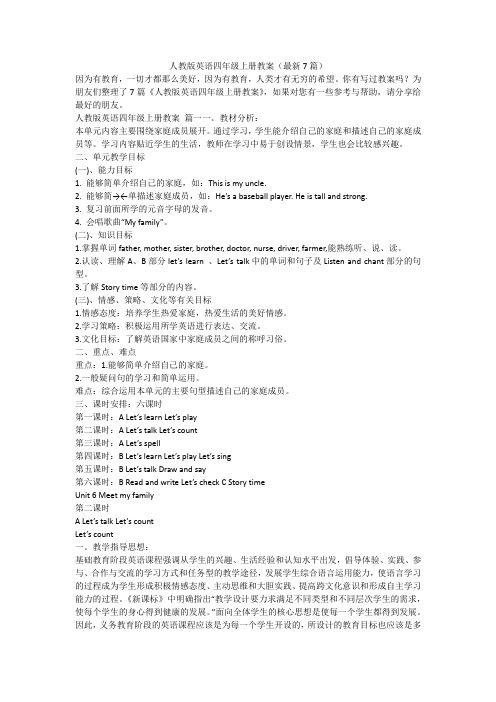
人教版英语四年级上册教案(最新7篇)因为有教育,一切才都那么美好,因为有教育,人类才有无穷的希望。
你有写过教案吗?为朋友们整理了7篇《人教版英语四年级上册教案》,如果对您有一些参考与帮助,请分享给最好的朋友。
人教版英语四年级上册教案篇一一。
教材分析:本单元内容主要围绕家庭成员展开。
通过学习,学生能介绍自己的家庭和描述自己的家庭成员等。
学习内容贴近学生的生活,教师在学习中易于创设情景,学生也会比较感兴趣。
二、单元教学目标(一)、能力目标1. 能够简单介绍自己的家庭,如:This is my uncle.2. 能够简→←单描述家庭成员,如:He’s a baseball player. He is tall and strong.3. 复习前面所学的元音字母的发音。
4. 会唱歌曲“My family”。
(二)、知识目标1.掌握单词father, mother, sister, brother, doctor, nurse, driver, farmer,能熟练听、说、读。
2.认读、理解A、B部分let’s learn 、Let’s talk中的单词和句子及Listen and chant部分的句型。
3.了解Story time等部分的内容。
(三)、情感、策略、文化等有关目标1.情感态度:培养学生热爱家庭,热爱生活的美好情感。
2.学习策略:积极运用所学英语进行表达、交流。
3.文化目标:了解英语国家中家庭成员之间的称呼习俗。
二、重点、难点重点:1.能够简单介绍自己的家庭。
2.一般疑问句的学习和简单运用。
难点:综合运用本单元的主要句型描述自己的家庭成员。
三、课时安排:六课时第一课时:A Let’s learn Let’s play第二课时:A Let’s talk Let’s count第三课时:A Let’s spell第四课时:B Let’s learn Let’s play Let’s sing第五课时:B Let’s talk Draw and say第六课时:B Read and write Let’s check C Story timeUnit 6 Meet my family第二课时A Let’s talk Let’s countLet’s count一。
四年级上册人教版英语教案6篇

四年级上册人教版英语教案6篇四年级上册人教版英语教案篇1where are you going to go教学目标:1、能够识别单词:list airport shoe ticket toothbrush.2、学习目标语句:where are you going to go what are you going to take when are you going to go who’s going to go with you3、功能:能够谈论旅行前的准备和具体事宜。
教学重点:1、掌握新单词,并能够理解旅行所准备的物品。
2、能够口头运用 where are you going to go what are you going to takewhen are you going to go to the airportwho’s going to go to the airport这类问句就具体信息提问。
教学难点:能够和同学用“where、 what、when、who”这四个单词开头的疑问句谈论旅行前的准备。
教学用具:录音机、ppt教学过程:step1、warm-up师生之间相互问候step2、presentation free talkt:the summer holiday is coming ,so where are you going to go in your summerholidays when are you going to go there what are you going to take what are you going to do there who is going to go with you (生逐一回答后,师总结):i think you had a lovely time, yes 由此活动引出where, when, what, who等特殊疑问词,并带领同学们复习一般将来时的用法。
人教版小学四年级上册英语教案全册5篇

人教版小学四年级上册英语教案全册5篇人教版小学四年级上册英语教案全册1教学内容:Look and read Play a game教学目标:1. 知识目标:Using possessive adjectives to show possession Using nouns phrases to identifypeople,animals,events,objects and activities Asking simple questions to obtain yes/no answers2. 能力目标:Communicate with teachers or other learners3. 情态目标:爱护绿化重点难点:Its stalk is long. Has it got …?Teaching aids:pictures,recorder教学过程:一、Warming –up1,Sing a song2,Daily talkRevision Review:stalk,leaves,flowers,roots,二、Presentation1.Show a picture of a plant with flowers. Ask:What is it?Is it a tree? To elicit:a plant/ Ask:What colour are the flowers? What colour are the leaves? To elicit:They?re… Ask:Are they long or short? To elicit:They?re long(short) .2.Draw another plants. Say:Look at this plant.Its flowers are red. Look at that plant .Its flowers are purple.3.Listen to the tape.4.Say sth.about the plant .Show a picture of a tree. Introduce:a trunk,branches.Make sentences:Its trunk is big. It branches are long.Listeen to the tape.Say sth about the tree.Play the cassette:Play a game/ Listen and repeat.Play this game.三、Consolidation1.Photocopiable pages 44-45.2.Workbook page 29.3.Grammar practice book 4a page 35.板书设计:Unit 2 Look at,,, Its stalk is…Its trunk is…leaves are …branches… roots flowers人教版小学四年级上册英语教案全册2教学目标:1.能听懂、会说、会读交际用语:Wele to … What arethese/those?They’re …Are these/those …? Yes, they are./No, they aren’t2.能听懂、会说、会读词汇:they’re=they are, pig, cow, chicken, duck3.能听懂、会说、会读、会写词汇:farm, they, pig, apple, those4.能熟练朗读对话或表演对话。
新人教版小学四年级上册英语全册教案

新人教版小学四年级上册英语全册教案单元一:Hello课时一:Greeting- 教学目标:研究常见的问候语并能正确使用- 教学内容:- 问候语:Hello, Hi, How are you?, I'm fine.- 回答问候:I'm fine, Thank you.- 教学活动:- 教师出示图片,模型口头展示不同问候语的用法。
- 师生互动:教师和学生通过互相问候进行练。
- 情景对话:学生分组,模拟不同场景下的问候和回答。
课时二:Numbers- 教学目标:认识数字1-100,学会用英语进行简单的数数。
- 教学内容:- 数字1-100:one, two, three, ..., one hundred.- 数数的方法和规则。
- 教学活动:- 教师出示数字卡片,模型口头教学如何念数。
- 学生跟读并模仿教师的发音。
- 数字练:教师提问学生,学生用英语回答。
单元二:Family课时一:Family Members- 教学目标:研究家庭成员的称呼,并能正确运用。
- 教学内容:- 家庭成员词汇:father, mother, brother, sister, grandparents.- 家庭成员的问候。
- 教学活动:- 教师用图片和模型演示不同家庭成员的称呼。
- 学生跟读并模仿教师的发音。
- 情景对话:学生分组,模拟不同家庭成员之间的问候。
课时二:My Family- 教学目标:能够用英语介绍自己的家庭成员,并能描述他们的特征。
- 教学内容:- 自我介绍:My name is ..., I have a family.- 家庭成员的介绍和描述。
- 教学活动:- 教师示范如何进行自我介绍。
- 学生模仿自我介绍,并介绍自己的家庭成员。
- 学生小组合作,描述自己最喜欢的家庭成员,并向全班展示。
单元三:My Day课时一:Daily Routine- 教学目标:研究描述日常活动,并能正确运用。
- 教学内容:- 日常活动词汇:get up, wash face, brush teeth, have breakfast, go to school, etc.- 描述日常活动的句型。
人教版小学四年级英语教案上册【5篇】
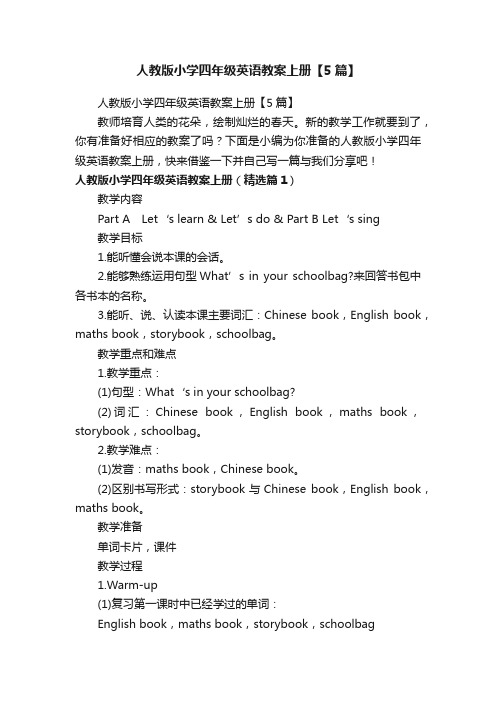
人教版小学四年级英语教案上册【5篇】人教版小学四年级英语教案上册【5篇】教师培育人类的花朵,绘制灿烂的春天。
新的教学工作就要到了,你有准备好相应的教案了吗?下面是小编为你准备的人教版小学四年级英语教案上册,快来借鉴一下并自己写一篇与我们分享吧!人教版小学四年级英语教案上册(精选篇1)教学内容Part A Let‘s learn & Let’s do & Part B Let‘s sing教学目标1.能听懂会说本课的会话。
2.能够熟练运用句型What’s in your schoolbag?来回答书包中各书本的名称。
3.能听、说、认读本课主要词汇:Chinese book,English book,maths book,storybook,schoolbag。
教学重点和难点1.教学重点:(1)句型:What‘s in your schoolbag?(2)词汇:Chinese book,English book,maths book,storybook,schoolbag。
2.教学难点:(1)发音:maths book,Chinese book。
(2)区别书写形式:storybook与Chinese book,English book,maths book。
教学准备单词卡片,课件教学过程1.Warm-up(1)复习第一课时中已经学过的单词:English book,maths book,storybook,schoolbag(2)教师利用已经学过的单词自编chant如下:English book,English book,I have an English book.Maths book,maths book,I have a maths book.Storybook,storybook,I have a storybook.Schoolbag,schoolbag,I have a schoolbag.2.Presentation(1)教师手拿出书包,提问:What is this?教师出示单词卡,学生回答Schoolbag,并让学生指一指自己的schoolbag。
人教版四年级英语上册教案全册教案4篇
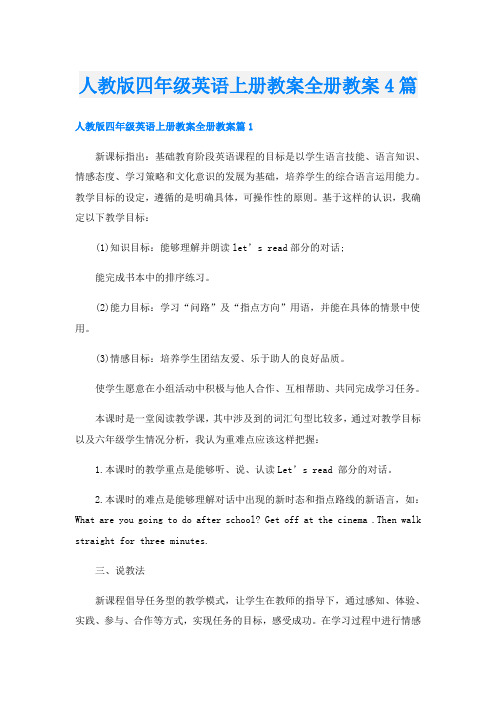
人教版四年级英语上册教案全册教案4篇人教版四年级英语上册教案全册教案篇1新课标指出:基础教育阶段英语课程的目标是以学生语言技能、语言知识、情感态度、学习策略和文化意识的发展为基础,培养学生的综合语言运用能力。
教学目标的设定,遵循的是明确具体,可操作性的原则。
基于这样的认识,我确定以下教学目标:(1)知识目标:能够理解并朗读let’s read部分的对话;能完成书本中的排序练习。
(2)能力目标:学习“问路”及“指点方向”用语,并能在具体的情景中使用。
(3)情感目标:培养学生团结友爱、乐于助人的良好品质。
使学生愿意在小组活动中积极与他人合作、互相帮助、共同完成学习任务。
本课时是一堂阅读教学课,其中涉及到的词汇句型比较多,通过对教学目标以及六年级学生情况分析,我认为重难点应该这样把握:1.本课时的教学重点是能够听、说、认读Let’s read 部分的对话。
2.本课时的难点是能够理解对话中出现的新时态和指点路线的新语言,如:What are you going to do after school? Get off at the cinema .Then walk straight for three minutes.三、说教法新课程倡导任务型的教学模式,让学生在教师的指导下,通过感知、体验、实践、参与、合作等方式,实现任务的目标,感受成功。
在学习过程中进行情感和策略调整,以形成积极的学习态度,促进语言实际运用能力的提高。
同时英语课程要面向全体学生,注重素质教育,要关注每个学生的情感,激发他们学习英语的兴趣,帮助他们建立学习的成就感和自信心,使他们在学习的过程中发展综合语言运用能力,提高人文素养,培养创新精神。
基于以上认识,我以新课程为指导,以学生为主体,让学生通过游戏、对话、思考,观察等来体验语言,体验生活,体验学习的过程与快乐。
(1)情境法。
通过呈现地图创设问路情境,让学生在形象的语言环境中学习、运用新知。
人教版四年级英语上册教案册(5篇)
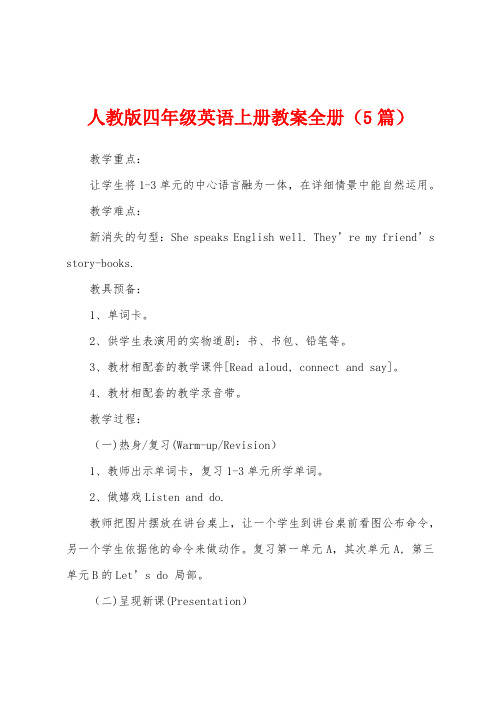
人教版四年级英语上册教案全册(5篇)教学重点:让学生将1-3单元的中心语言融为一体,在详细情景中能自然运用。
教学难点:新消失的句型:She speaks English well. They’re my friend’s story-books.教具预备:1、单词卡。
2、供学生表演用的实物道剧:书、书包、铅笔等。
3、教材相配套的教学课件[Read aloud, connect and say]。
4、教材相配套的教学录音带。
教学过程:(一)热身/复习(Warm-up/Revision)1、教师出示单词卡,复习1-3单元所学单词。
2、做嬉戏Listen and do.教师把图片摆放在讲台桌上,让一个学生到讲台桌前看图公布命令,另一个学生依据他的命令来做动作。
复习第一单元A,其次单元A, 第三单元B的Let’s do 局部。
(二)呈现新课(Presentation)1.Free talk.教师与学生就有关教室、学习用品、朋友的话题做问答练习。
What’s in the classroom?What’s in your schoolbag?Who’s your friend?2、教师通过录像、VCD、教学课件等给学生展现Read aloud对话。
3、让学生观看后回答下列问题:What’s in Amy’s schoolbag? (English book, maths book, notebook, ten storybooks)Who’s Amy’s friend? (Sandy White.)4、听录音带,让学生跟读本局部对话。
5、让学生表演对话。
启发学生用Who’s your friend? He/She has…,What’s her/his name?表达更多的句子。
6、依据对话回答下列问题:Is Amy’s schoolbag heavy?What’s in it?Are the story-books Amy’s?(They’re Amy’s friend’s story-books.)教师给学生解释这一句话:Mary is my friend. They are my friend’s books 。
全册(教案)人教PEP版英语四年级上册

全册(教案)人教PEP版英语四年级上册教学内容:本册教学内容为人教PEP版英语四年级上册,共包括四个单元,分别是Unit 1 My Classroom, Unit 2 My Schoolbag, Unit 3 My Friends, Unit 4 My Home。
每个单元都围绕一个具体的话题展开,通过听、说、读、写等多种形式,让学生在真实语境中学习英语。
教学目标:1. 能够听懂、会说、会读本册的单词、短语和句子。
2. 能够运用本册所学的词汇和句型进行简单的日常交流。
3. 能够通过图片、实物、情景等多种方式理解和表达本册所学的语言知识。
4. 培养学生的英语学习兴趣和自主学习能力。
教学难点:1. 单词的发音和记忆。
2. 句型的正确运用和口语表达。
3. 听力理解能力的提高。
4. 语法知识的理解和运用。
教具学具准备:1. 教学课件或黑板。
2. 单词卡片或实物。
3. 录音机或音响设备。
4. 学生课本和练习册。
教学过程:1. 导入:通过图片、歌曲、故事等方式引起学生的兴趣,导入本课的话题。
2. 新课内容展示:通过课件、黑板、实物等展示本课的单词、句型和语法知识。
3. 学生参与:通过听、说、读、写等多种形式让学生参与课堂,巩固所学知识。
4. 小组活动:学生分组进行角色扮演、讨论、游戏等活动,提高口语表达和合作能力。
板书设计:1. 单词和短语:在黑板上列出本课的单词和短语,进行讲解和练习。
2. 句型:在黑板上展示本课的句型,进行讲解和练习。
3. 语法知识:在黑板上展示本课的语法知识,进行讲解和练习。
作业设计:1. 听力练习:听录音,完成相应的练习题。
2. 口语练习:模仿课文对话,进行角色扮演。
3. 阅读练习:阅读课文,回答相关问题。
4. 写作练习:根据课文内容,进行写作练习。
课后反思:1. 教学过程中是否达到了预期的教学目标。
2. 教学难点是否得到了有效的解决。
3. 学生的参与度和学习兴趣是否得到了提高。
4. 教学方法和教学手段是否适合学生的实际情况。
四年级上册英语教案人教版

四年级上册英语教案人教版四年级上册英语教案人教版通用5篇“教师”就应是个具有超卓的德行持重明达和善的人,每一个教师都应该懂得写一篇教案。
下面是我为你准备的四年级上册英语教案人教版,快来借鉴一下并自己写一篇与我们分享吧!四年级上册英语教案人教版篇2课型:新授课课时:1 课时教材:人教版四年级上册Unit 4 My Home Let’s learn教学目标:1.知识目标:借助图片、课文,能准确认读单词或短语bedroom,study,living room,kitchen,bathroom。
能熟练运用特殊疑问句Where is...?和一般疑问句Is she/he in the...? 对人物的位置进行提问。
2.能力目标:能用所学的句型和单词对人物的方位进行提问和回答。
能认识家里各个房间的名称和功能,并能够说出和表演出能在相应房间中做的活动,如watch TV,read a book,havea snack,have a nap,take a shower 等。
3.情感态度与价值观目标:能够理解家的重要性和意义,并能够培养良好的生活和家庭习惯。
能体会到英语学习的乐趣,并能与教师、同学积极交流。
教学重点:精通并准确运用本课单词或短句以及句型描述人物方位。
教学难点:理解良好生活习惯的重要性。
教学工具:教材,音频,多媒体课件。
教学过程:Step1:Lead-inGuessing Game:课前,教师和同学们做一个小游戏。
教师来表演动作,学生一起猜。
教师分别表演动作watch TV,read a book,have a snack,have a nap,take a shower,学生用英文答出相应的动作。
教师注意嘉奖答得又快又准确的同学。
游戏过后,教师提问学生可以在哪里做这些活动呢?“Where can we watch TV/ read a book/ have a snack...? ”由此引出My Home 的主题。
人教版四年级上册英语教案 人教版小学四年级英语教案上册(优秀6篇)

人教版四年级上册英语教案人教版小学四年级英语教案上册(优秀6篇)人教版小学四年级英语上册教案篇一二、教学目标1、学生能根据听到的动物词汇识别相应的图片,能根据图片说出单词:bear squirrel pig mouse bird elephant.2、让学生能积极参与教学活动,在课堂上充满自信,敢于开口,乐于模仿,勇于表演。
3、培养学生与同伴合作的学习精神。
三教学重点:让学生能听、说、认、读六个关于动物的单词。
四、教学难点:模仿动物的动作,单词:squirrel elephant的发音。
五、教学准备:1、六种小动物的头饰。
2、六种小动物的图片和单词卡片。
3、学生自带的相关的动物图玩具。
六、学情分析1、学生情况分析本课时所执教的对象是本校四年级一班的学生,虽然是四年级,但是由于地区的特殊性,他们和三年级的学生一样都是刚接触英语课,对英语有强烈的好奇心和学习热情,但孩子们的兴趣持续不了多久,因此,就要求教师在课堂上设计生动活泼、形式多样的活动来吸引他们的注意力,让孩子们的兴趣能持之以恒。
这个班由58名学生组成,其中有三名学困生,课堂中,大多数学生学习积极性比较高,能积极的参与到课堂活动中来,他们善于表演,乐于模仿,接受能力也比较强,每节课所要求学会的内容也都能够掌握,但三名学困生在知识掌握方面有一定的难度。
2、教材分析本课时是动物这个话题b部分的第二课时,因动物是学生比较熟悉和感兴趣的事物,而学生在上一课时中也已经学过一些关于动物的单词,因此,学生在学习时应该是不太困难,本课时的主要目的是要求学生对六个单词能听、说、认、读。
并能作简单的表演。
七、教学设计思路1、revision①、日常用语会话:what’s your name? how are you ? goodmorning等,其目的是为了让学生能熟练的运用前面学过的问候语及口语进行会话。
②、复习第一课时中学过的几种动物,要求学生用“i have a …”的句型说出来。
人教版四年级上册英语教案7篇

人教版四年级上册英语教案7篇人教版四年级上册英语教案篇1一、教学目标与要求1、能听懂,会说:wele to my home!并能简单描述自己的房间。
2、能听、说、认读study、 bathroom、 bedroom 、living room、 kitchen等单词并能在日常生活中运用。
3、能听懂let’s do中的指示语,并按照指令做出相应的动作。
二、教学重难点分析让学生在语言的学习和活动中听、说、认读生词。
三、课前准备1、教师准备study 、bathroom 、bedroom 、living room、kitchen等单词的图片。
2.老师要准备文具,比如铅笔,尺子,书和钢笔。
四、教学步骤1)热身1、游戏:猜谜语(白色的马是什么马?黑色的马是什么马?黑白相间的马?黑白红的马是什么马?)2、教师与学生进行日常对话,如:hello!how are you?2)预习教师拿出一些文具用品,帮助学生复习句型:“what’s this?it’s a……”“where’s the……?it’sin/on/under……”3)新课呈现let’s learn1、教师出示画图,手指着图片上书房里的书问:what are they?学生回答books.教师问:where are the books?告诉学生:they’re in the study.2、教师重复生词:study,学生学说。
(分解单词,拼写)用同样的方法教学其它生词。
3、让学生听录音,跟读let’s learn部分的词汇。
以后打乱顺序,要求学生边听边指,力求学生做到“眼到、手到、口到、心到”。
4、游戏:看谁反应快。
a、教师把各个房间的图片贴在黑板上,然后把全班学生分成两大组,每组选出一个学生,比赛看谁反应快。
比如:教师说:kitchen.学生跑到黑板前,谁先跑到前面碰到单词为胜者。
b、where is the study/……?it’s here.教师说“书房”在哪?学生持有此卡片的就说it’s here.然后上讲台带领其它同学读,并拼读出来。
- 1、下载文档前请自行甄别文档内容的完整性,平台不提供额外的编辑、内容补充、找答案等附加服务。
- 2、"仅部分预览"的文档,不可在线预览部分如存在完整性等问题,可反馈申请退款(可完整预览的文档不适用该条件!)。
- 3、如文档侵犯您的权益,请联系客服反馈,我们会尽快为您处理(人工客服工作时间:9:00-18:30)。
课题: Unit One My classroom第一课时教学设计方案12教学目标:31.能听懂、会说:What's in the classroom? Aboard, two lights, many desks 4and chairs.并能在实际情景中运用。
52.能听、说、认读本课主要单词:classroom, window, door, picture, board, light, 63.能听懂并能按照指令做事情。
7教学重点:学习What's in the classroom?及相关单词:classroom, window, door,8picture, board, light。
9教学难点:101. window一词注意w的发音,不要与v的发音混淆,教师在教学中应及时纠正。
112.在回答"What's in the classroom?"时,注意单词复数的读音。
12教具准备:131.教材相配套的教学课件[Unit 1 Let's learn/A]142.教材相配套的教学录音带153.教师自制的单词卡164.一张画有教室的大图17教学过程:18(一)热身、复习(Warm-up / Revision)191.教师播放第一册Recycle 1单元中得"Chant and find"部分,学生跟着录音一起20说。
212.教师出示与chant内容相符的图片,问:"What's in the picture?"让学生进行22回答。
Picture一词由这里引出。
233.复习pencil, ruler, bag, book, pencil-case, sharpener, eraser, crayon,pen 24等单词。
254.引导学生用以上单词做问答练习,如:What's in the bag? What's in the26pencil-case ?275.在学生回答出问题后,教师可再追问:How many pencils/pens…?使学生能用复28数进行回答。
如:What's in the pencil-case? A ruler, two pencils…29(二)呈现新课(Presentation)301.教师把一张画有教室的大图贴到黑板上,说:This is a classroom. What's in the 31classroom?322.学生听懂后,教师可先试着让学生回答,能说出英文的学生给与表扬(desk, chair, 33picture都已学过),也可让学生用中文回答。
343.告诉学生我们要学习有关classroom的内容,教读classroom354.让学生观看本部分的教学课件2遍。
[Unit 1 Let's learn/A]365.让学生看着课件的画面回答:What's in the classroom? (在看了两遍课件的基37础上,考查学生的听力和记忆能力)学生不见得都能回答出来,能说出部分即可。
教师可针对学38生回答的不同程度进行指导,鼓励学生完整的回答出来。
如有困难,可再看一遍本部分的教39学课件。
40What's in the classroom?41A board, two lights, many desks and chairs…42当学生只回答出 board, light, desk and chairs 时,教师进一步再问:How many?43引导学生说出:A board 或One board. Two lights. 教师可以直接把many一词告诉学生。
446.教师分别指着黑板,灯,桌子和椅子让学生说出单词。
457.出示单词卡,让学生进行认读。
教师可以告诉学生一些记忆单词的方法。
如观察46单词的第一个字母和最后一个字母等。
(把单词卡贴到黑板上)478.学生跟读并模仿Let's learn部分的内容。
(使用教材相配套的教学录音带)489.教师在学生学习了对话的基础上,扩充词汇量:There are many things in the 49classroom. What are they?5010.让学生观看教学课件,学习其它单词。
可从已学的单词过渡到新单词。
5111.教师指着教室中的相关事物问学生:What's this?让学生回答。
5212.教师出示单词卡,让学生进行认读。
(并把单词卡贴到黑板上)5313.看黑板上所贴的单词卡,读出单词。
5414.让学生做pair work: 根据教室中的实际情况,自编对话5515.学生展示练习情况,教师注意学生对名词复数的运用,及时给与指导。
纠正学生56错误时注意方式方法,不要打击学生学习的积极性。
对于说得很好的学生应及时表扬。
5716.教师和学生用英语进行交流,导入Let's do的学习。
I can do many things in 58the classroom.: Open the door, turn on the light, clean the window, put up the picture, 59clean the board and sweep the floor. 教师尽量把说话的速度放慢一些,边说边做出相应60的动作,以便使学生理解。
6117.教师先说词组, 然后再让能力较强的学生代替教师发布指令,让其他学生根据指62令做出相应的动作。
建议多让一些学生参与进来,激发学生学习英语的兴趣。
63(三)趣味训练(Practice)64游戏1:65做"Listen an find"的游戏。
以小组为单位,小组内的每个学生都被指定为一个本课66所学单词,然后教师读单词。
如:教师读door, 那么各组被指定为这个单词的学生就必须马67上跑到教室门的位置。
然后由各组的其他同学判断对错。
对了加分,教师接着读下一个单词,68游戏继续。
最后,比一比哪个组得分最多,哪个组就获胜。
69游戏2:70做"找朋友"的游戏。
(此时黑板上已贴有一张大的教室图片和单词卡)让学生把单词71卡贴到图中相应的地方。
贴好后,让其他学生判断对错。
如果对了,就大声朗读出来;如果72错了,请他人改错后再读出来。
73如果可以的话,这个游戏还可把单词卡直接贴到教室中相应的地方。
以便使学生更好74的记忆单词。
75(四)作业布置(homework)76Listen, draw and say771.教师发给每个学生一张图画纸。
782.教师说一段话,学生根据所听到的内容在纸上作画。
79所听内容:This is my classroom. What's in the classroom? A picture, two boards, 80two doors, three windows, six lights , many desks and chairs.813.请学生说出自己所画的内容,核对答案。
824.两人一组,看图做问答。
83板书设计:84教学后记:85学生对英语的学习兴趣很浓。
8687第二课时教学设计方案88课题:Unit One My classroom89教学目标:1.听懂、会说并能在日常生活中运用We have...这一句型。
902.听懂、会说表建议的句子"Let's go and have a look."913.能听懂、会说并能恰当使用表示方位的词near。
92教学重点:学习句子We have a new classroom. We have 6 new lights;学习用near 93表示方位。
94教学难点:学生对our 和my 的表达要比理解稍难些。
our 一词的发音对学生来说读准不95太容易。
96教具准备:971.学生自带一件物品,最好是有关已学过的英文单词。
982. Amy, Mike 和Zhang Peng的面具。
993.一张画有教室的大幅图片。
1004.教材相配套的教学课件。
[Unit 1 Let's talk/A]1015.教材相配套的教学录音带。
102教学过程:103(一)热身、复习(Warm-up/Revision)1041.复习已学句型:This is… I have… 教师手拿一个毛绒玩具,说:I have a dog , 105this is my new dog.1062.让学生用事先准备好的实物模仿句子1073.当学生能够说出句子时,教师可提问:Where is it? 启发学生用学过的知识回答:108It's on/in/under/the …1094.在学生回答Where is it?时,教师可以适当的加入near 一词,It's near the (110)让学生在实际的情景中理解near 的含义并运用。
111(二)呈现新课(Presentation)1121.教师出示Amy和Mike的面具,问:Who's he? Who's she?学生回答出Amy和Mike 113后,教师补充:Amy and Mike are classmates. 让学生猜classmate 的含义。
教读classmate 1142.教师介绍新人物并展示情景对话:出示面具This is Zhang Peng, he is Amy and 115Mike's new classmate. They have a new classroom. Do you want to have a look? Ok, Let's 116go and have a look.(间接引出新句子) 教师出示一张教室图并把它贴到黑板上:This is a 117new classroom.提问:What's in the classroom? (让学生先熟悉一下对话情景。
)1183.让学生带着问题观看本部分的教学课件。
[Unit 1 Let's talk/A]119How many lights in the classroom?120Is the new classroom big?121Where is ZhangPeng's seat?1224.让学生通过视听来回答教师所提出的问题,有困难的地方教师要做必要的帮助。
1235.学生跟读并模仿Let's talk部分的内容。
(使用教材相配套的教学录音带)1246.请学生解释We have a new classroom. We have 6 new light. 让学生结合实际125情况用We have…说句子。
